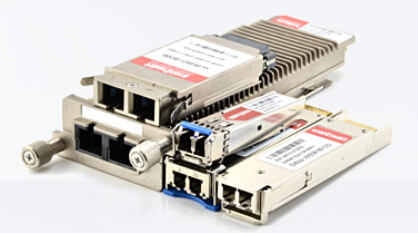Fiber optic transceivers is a self-contained component that can both transmit and receive. Usually, it is inserted in devices such as routers or network interface cards which provide one or more transceiver module slot, such as GBIC module, SFP transceiver, XFP, etc.
Fiber Optic Transceivers Today
Fiber optic transceivers for applications in the field of datacom are mostly characterized by a couple of established international standards. These standards define the electro-optical performance of a transceiver/transponder as well as its pinout and its physical outline and package, including the corresponding fiber optic connector interfaces.
Fiber optic transceivers meeting these standard are operating worldwide in numerous applications in mainframes, server clusters, storage area networks, wide area networks, and local area networks, and currently around 20 to 30 worldwide competing suppliers have been established. The number of partners involved in some important multisourcing agreements has seen an increase since 1989. This is also indicative of the increasing importance of industrial associations where both suppliers and applicators are represented. This speeds up the market penetration of novel components, systems, and applications. Nowadays, this does not seem to generate conflicts with the commonly agreed normative power of international standardization organizations such as the Internationnal Organization for Standardization (ISO), International Electrotechnical Commission (IEC), and International Telecommunication Union (ITU).

The demand for these transceivers has continuously increased during the past 10 years, and the prices have shown dramatic decreases of order of 25% per year. Consequently, the goal of all manufacturers is to offer a high level of performance, reliability, quality, and serviceability while maintaining cost-effective production in the face of drastically increased volumes to meet the market pricing.
Some Aspects of Tomorrow's Transceivers
The bit rates of fiber optic transceivers are continuously increasing in order to meet the worldwide demand for ever higher bandwidths. These bandwidth increases are called for by both existing storage and networking markets, as well as the parallel computing industry and high end server design.
In the past 10 years, a significant reduction of transceiver module size was possible due to significant progress in the downsizing of optical subassemblies and associated passive and active electronic comparison of the ESCON/SBCON outline, multistandard, small form factor (SFF), and parallel SNAP-12 transceivers. The function of the transceivers shown is described in detail in my previous blog posts.
Future transceiver design is likely to focus on power consumption, electromagnetic compatibility and immunity, and density. As data rates continue to increase, we will start to see transceivers used closer to the ICs on the board and not just at the card edge. It has also been demonstrated the is possible to incorporate optical components onto a chip, completely avoiding the deficiencies of high-speed signals on copper board traces. While these advancements may take their place in high-end computing systems, classical card edge transceivers are likely to continue to play their role into the foreseeable future to allow fiber cable connection for SANs and networking.
Where to Buy Fiber Optic Transceivers
Fiber optic transceiver is a very popular format that's recommended by a large number of fiber optic component providers. Fiberstore provide a full range of optical transceivers. Cisco, especially, you can find a full product line of our Cisco SFP modules, such as Cisco GLC-T 1000BASE-T, SFP-GE-T, GLC-FE-100LX, etc. Our SFP and SFP+ moduels are 100% compatible with a good price and enjoy same-day shipping.


 – Datacom applications using 10 Gigabit Ethernet and 2x/4x/8x/16x Fibre Channel (LW and SW)
– Datacom applications using 10 Gigabit Ethernet and 2x/4x/8x/16x Fibre Channel (LW and SW)



